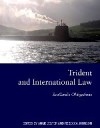There are a number of different ways to achieve peace and justice. We need to work to build a just world through sustainable development which involves ordinary people at the grassroots, we need to find creative ways of resolving conflict, and we need to build alternative structures and communities along sane and sustainable lines.
Some situations require us to engage in active nonviolence. For instance, where there is a disparity in power between two sides in a conflict so that the powerless side has to take action so that negotiations can start. The need may be as basic as to demand recognition from the powerful that they are fellow human beings, or to get them to see that there is a problem. Or the situation may be one of such structural injustice that it cannot be improved or reformed, but has to be transformed.
The aim of nonviolence is both dialogue and resistance - dialogue with the people to persuade them, and resistance to the structures to compel change. ACTION AWE also has these aims, and will through nonviolent civil resistance apply a critical public pressure for the disarmament of Britain’s nuclear weapons.
ACTION AWE’S Commitment to Nonviolence
Nonviolence is fundamental for activists seeking peace and justice through political change, so it is a requirement of participation in Action AWE that our actions must be nonviolent. That does not mean they have to be passive. Far from it: we want to inspire visible, unpredictable and politically effective actions that disrupt and challenge the military-nuclear establishments. Nonviolent blockades, fence-cutting, occupations and painting of military facilities and vehicles can be creative ways to halt militarism, open doors in the bases and communicate civil society’s political opposition to oppressive nuclear and military activities.
While recognising that violent means can force political and governmental changes, history and experience show that the use of coercion and violence cannot bring about real peace, justice, liberation or positive social transformation. Peace and justice movements in many parts of the world have developed philosophies and practices of nonviolence for resisting oppression, resolving conflicts and creating sustainable political change. Though there may be differences in how different groups interpret and practice nonviolence, they share a fundamental care and respect for living things and a commitment to prevent and avoid violence, notably towards adversaries and people employed to maintain undemocratic or military systems that we oppose. However passionate our beliefs in the justice and rightness of our cause, we also carry the awareness that we may be wrong, so we seek to persuade not to force, and to keep ourselves open to new ideas and arguments as well. Hence, we reject the notion that the ends justify the means. Nonviolence ensures that our means are consistent with our ends. While respecting that others may take different views, we share here some of the basic underpinnings of our nonviolence and guidelines for participants in Action AWE.
The aims of nonviolence – and of Action AWE – are communication, resistance and transformation. Taking into account the structures of power and militarism, we seek actions that will raise awareness and communicate with people in positions of power, people working at the nuclear facilities, and people living and working nearby. Dramatic symbolic actions can be used to expose problems and reveal truths. ‘Creative disorder’, such as demonstrations, marches, blockades, entering prohibited places (sometimes known as peaceful invasions) attract attention and can mobilise civil society and opinion-formers, leading to change. Other tactics of nonviolence may involve non-cooperation – for example through strikes, boycotts, peace camps, sit-ins (and variations such as die-ins, dance-ins etc), as well as civil disobedience and refusal to follow orders or comply with unjust or oppressive laws.
Nonviolent actions may also directly block or disrupt state-sponsored violence, including nuclear weapons deployments and facilities. In some cases, our actions may result in arrests and civil or criminal charges, e.g. for breaching legal restrictions designed to prevent protest or conceal or protect military or commercial activities. See Action AWE’s legal briefing for more about the laws that may apply in this case. If our actions are nonviolent, responsible and well prepared, then being arrested, contesting the charges in court, and even being convicted and imprisoned, can provide highly visible and effective tools for raising awareness of our objectives and arguments and creating politically effective pressure.
The objective of Action AWE is to create visibility and political impact to eradicate nuclear weapons, and it is up to participants themselves whether they undertake actions that are arrestable or not, provided that they are in accordance with nonviolence principles and intentions. We believe that the means we use are our ends in the making, and must be consistent with our objectives of peace, justice and a sustainable environment for life on earth. We can provide preparation and training for people who are new to nonviolent campaigning. We ask that everyone taking part in ACTION AWE respect and act in accordance with these guidelines:
- Respect and care for everyone involved, including those representing or defending the opposing positions and/or facilities.
- Refusal to harm, damage or degrade people.
- Refusal to carry any weapon or use physical or verbal abuse against others.
- Recognition that no one has a monopoly on truth: everyone is capable of change, and communication and dialogue are important for understanding others’ positions and concerns.
- Connect with the fundamental humanity and good in everyone, whatever side of the issue they are on.
- Be fully responsible, self-conscious and accountable for ourselves and our actions, which is best ensured by avoiding alcohol and drugs (other than for medical needs).
- We seek to prevent and avoid harm to everyone involved, including ourselves, but there may be situations in which suffering is inevitable; in that case all efforts must be taken to prevent suffering being inflicted on others, even if that means taking it on ourselves.
- We do our best to provide each other with support to ensure that our behaviour is as nonviolent and careful as possible.
Why Nonviolence?
Unarmed truth is the strongest power in the universe.
Martin Luther King
In all our direct action, trainings and workshops we emphasise that all our actions are totally non-violent. This paper explains briefly why this is so important.
Pragmatic reasons
- The state or the powerholders can always muster more force against protesters than we can. In the last resort, if violence is the tactic, they can always resort to greater violence and can always command more forces and resources.
- Violence used by protesters gives a negative image, and very often alienates the people we are trying to rally to our side. It plays into the hands of a negative press.
- Violence, while seeming to be effective in the short term, never produces long-term solutions. There is always a residue of hurt and pain that will erupt later.
Philosophical reasons
- Bringing about peace by violent means is a real contradiction in terms. Peace can only come about by peaceful processes.
- Respect for others is at the heart of nonviolence. By our actions we are seeking to win our opponents over to our way of thinking, and this involves a change of heart, which cannot be achieved by force.
Most important of all: Nonviolence works.
Some examples where nonviolence has worked.
In all these examples nonviolence has been part of a long and often costly struggle. Sometimes it has only achieved partial success, and often there are still issues to be resolved or carried further. However the important thing is that nonviolent action has won results that have changed the course of history.
Human Rights
- Slavery
- By the eighteenth and nineteenth century, slavery was seemingly entrenched as a fundamental part of the economic structure, and yet within fifty years it was abolished and, although it still exists, the concept has become unacceptable. This was achieved by the tireless work of many politicians, philanthropists, and also active tactics, such as boycott and symbolic action.
- Women’s suffrage.
- The campaign to win universal voting rights for women in Britain at the beginning of last century, employed many tactics of direct action well beyond parliamentary lobbying. Women chained themselves to railings, disrupted the proceedings of parliament, destroyed letter boxes, went on hunger strike, and even died on the racecourse in protest. This, combined with the higher profile of women in paid employment, led to a time when the vote could no longer be denied.
- Trade Union Movement.
- The right to form trades unions to protect the rights of workers was only won through many years of costly campaigning in the face of powerful opposition from the vested interest of factory owners. Most memorable of the campaigns was the action of the Tolpuddle Martyrs, who continued to unite, even although they were transported to the then colonies in Australia for many years.
- The Civil Rights Movement in the U.S.
- Perhaps the most famous of all nonviolent campaigns was the struggle to win voting rights for black Americans. Starting with Rosa Parks’ refusal to sit at the back of a segregated bus, and moving to Martin Luther King’s leadership of the bus boycott in Montgomery, Alabama, the Civil Rights movement inspired a whole generation with the example of nonviolence in action.
- Denmark against Hitler.
- People often say that nonviolence couldn’t work against a dictator like Hitler. The people of Denmark were occupied by the Nazis, but had a very effective campaign of nonviolent resistance throughout the war. When Jews were ordered to wear a yellow star, the King wore one, and the order was dropped. Throughout the war no Jews were deported from Denmark. Norway also resisted effectively, and there was nonviolent resistance within Germany itself.
National Independence
- India.
- Gandhi’s struggle to free India from the British Empire has become a model of nonviolence that has inspired many other actions around the world. Not only did Gandhi’s tactics of boycott, building up of local self-respect and trade, open defiance of laws and taxes, such as the salt tax, and ultimately hunger-strike, eventually win India’s freedom, it also provided many of the philosophical ideals underlying nonviolence as a way of life.
- Pakistan.
- A less well-known contemporary and colleague of Gandhi was Badshah Khan, who transformed proud Pathan warriors into a nonviolent army 10,000 strong, who resisted the harshest of British imperialism to enable Pakistan also to be free from British domination.
- The Philippines.
- In the 1980’s the people of the Philippines rose up against the repressive dictatorship of President Marcos. Images were screened around the world of huge crowds out in the streets, of nuns and priests in the forefront of the resistance, climbing aboard tanks, giving the soldiers flowers and garlands, and eventually winning the police and the army onto their side, to overthrow the dictator.
- Czechoslovakia.
- In what has come to be known as the ‘velvet revolution’ the people of Czechoslovakia managed to break free from the might of Soviet domination in 1989. A previous uprising in 1953 had used violence and been crushed by the superior force of the Soviet military, but as a result of many many years of underground cultural and political resistance, people power took to the streets in Czechoslovakia, and became the starting point for many other former Soviet satellites to gain freedom, culminating in the breaking down of the Berlin Wall.
- Ukraine.
- More recently, we have seen the people of the Ukraine also taking to the streets in huge numbers to create the ‘Orange Revolution’ resisting Russian domination of their elections. These pictures of crowds of people standing out in the snow in Kiev day after day and refusing to disperse, was not the spontaneous action it appeared to be, but was the result of a year of intense organising.
Nuclear Disarmament
- Greenham Common.
- In 1982 a women’s peace camp was established at the U.S. air base at Greenham Common in opposition to the deployment of cruise missiles. Although missiles were deployed, records have shown that the U.S. were seriously restricted by the amount of public opposition, and ultimately the weapons were removed and the base returned to common land. This had a wide impact, not only on anti-nuclear campaigning, but also on the struggle for women’s rights.
- Anti-Trident Campaigns.
- There have been countless nonviolent action campaigns ever since the Aldermaston marches of the 60’s. Yet Trident is still here in spite of us all, so we could be said to have failed. However, our actions have influenced public opinion to a huge extent, we have the partial successes of the Test Ban Treaty and have actually created a general awareness and public opposition to nuclear weapons, that only needs the final push to get rid of them altogether. Trident Ploughshares and Faslane 365 are two more recent examples that have helped create the political will in Scotland to elect an anti-nuclear government. ACTION AWE will now provide the essential direct action push that is needed to support the many other organisations that are lobbying and educating for change.
So let’s get out there and give Trident the final push.
If you’d like information on where to find nonviolence training or help please visit our ‘Nonviolence Training’ pages
We also have an excellent number of downloadable direct action guides and manuals in our Action Guides & Handbooks section

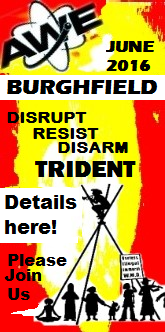
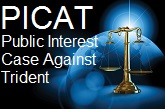
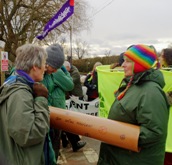





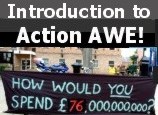

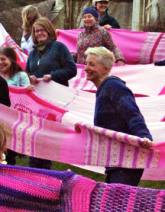
 Nuclear weapons crime in the UK has been reported to Thames Valley Police.
Nuclear weapons crime in the UK has been reported to Thames Valley Police.









